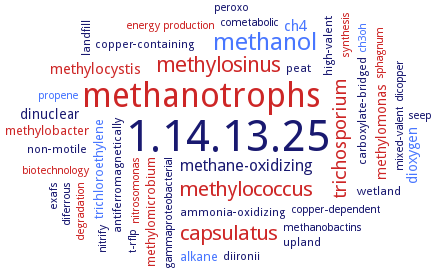1.14.13.25: methane monooxygenase (soluble)
This is an abbreviated version!
For detailed information about methane monooxygenase (soluble), go to the full flat file.

Word Map on EC 1.14.13.25 
-
1.14.13.25
-
methanotrophs
-
methanol
-
methylosinus
-
capsulatus
-
methylococcus
-
trichosporium
-
methane-oxidizing
-
methylocystis
-
ch4
-
methylomonas
-
dioxygen
-
dinuclear
-
methylobacter
-
trichloroethylene
-
methylomicrobium
-
alkane
-
diironii
-
ammonia-oxidizing
-
landfill
-
upland
-
antiferromagnetically
-
wetland
-
high-valent
-
non-motile
-
copper-containing
-
carboxylate-bridged
-
peat
-
copper-dependent
-
dicopper
-
ch3oh
-
nitrosomonas
-
cometabolic
-
diferrous
-
methanobactins
-
energy production
-
mixed-valent
-
gammaproteobacterial
-
sphagnum
-
t-rflp
-
seep
-
propene
-
synthesis
-
biotechnology
-
degradation
-
exafs
-
nitrify
-
peroxo
- 1.14.13.25
- methanotrophs
- methanol
- methylosinus
- capsulatus
- methylococcus
- trichosporium
-
methane-oxidizing
- methylocystis
- ch4
- methylomonas
- dioxygen
-
dinuclear
- methylobacter
- trichloroethylene
- methylomicrobium
- alkane
-
diironii
-
ammonia-oxidizing
-
landfill
-
upland
-
antiferromagnetically
-
wetland
-
high-valent
-
non-motile
-
copper-containing
-
carboxylate-bridged
-
peat
-
copper-dependent
-
dicopper
- ch3oh
- nitrosomonas
-
cometabolic
-
diferrous
-
methanobactins
- energy production
-
mixed-valent
-
gammaproteobacterial
- sphagnum
-
t-rflp
-
seep
- propene
- synthesis
- biotechnology
- degradation
-
exafs
-
nitrify
-
peroxo
Reaction
Synonyms
chcA, cytoplasmic methane monooxygenase, methane hydroxylase, methane mono-oxygenase, methane monooxygenase, methane monooxygenase hydroxylase, MmMmoC, MMO, MMO Bath, MMOB, MmoC, MMOH, MMOR, oxygenase, methane mono-, particulate methane monooxygenase, pMMO, sMMO, soluble methane monooxygenase, soluble methane monooxygenase hydroxylase
ECTree
Advanced search results
Application
Application on EC 1.14.13.25 - methane monooxygenase (soluble)
Please wait a moment until all data is loaded. This message will disappear when all data is loaded.
biotechnology
degradation
-
sMMO can be used for biodegradation of mixtures of chlorinated solvents, i.e., trichloroethylene, trans-dichloroethylene, and vinyl chloride. If the concentrations are increased to 0.1 mM, sMMO-expressing cells grow slower and degrade less of these pollutants in a shorter amount of time than pMMO
energy production
environmental protection
A0A2D2D5X0; A0A2D2D0T8; Q53563; A0A2D2D0X7
pulping wastewater still contains massive refractory organics after biotreatment, with high colority, low biodegradability, and lasting biotoxicity. To eliminate refractory organics in pulping wastewater, a methanotrophic co-metabolic system in a gas cycle Sequencing Batch Biofilm Reactor (gcSBBR) seeded by soil at a ventilation opening of coal mine is quickly built on the 92nd day. The removal rate of COD, colority and TOC is 53.28%, 50.59% and 51.60%, respectively. Analysis of 3D-EEM indicates that glycolated protein-like, melanoidin-like or lignocellulose-like, and humic acid-like decrease by 7.85%, 5.02% and 1.74%, respectively
synthesis
-
high particulate methane monooxygenase activity may contribute to the synthesis of poly-beta-hydroxybutyrate in the cell, which may be used to improve the yield of poly-beta-hydroxybutyrate in methanotrophs
biotechnology
-
high particulate methane monooxygenase activity may contribute to the synthesis of poly-beta-hydroxybutyrate in the cell, which may be used to improve the yield of poly-beta-hydroxybutyrate in methanotrophs
biotechnology
-
high particulate methane monooxygenase activity may contribute to the synthesis of poly-beta-hydroxybutyrate in the cell, which may be used to improve the yield of poly-beta-hydroxybutyrate in methanotrophs. Poly-beta-hydroxybutyrate content of strain OB3b can reach the highest level in the shortest time as compared to other methanotrophs. Nutrients deficiency condition is beneficial for strain IMV3011 to synthesize PHB whereas it is not beneficial for other strains
biotechnology
-
methanol can be employed to produce large amounts of Methylosinus trichosporium biomass containing sMMO. Enzyme expression can be maintained during growth on methanol which may aid in the development of sMMO-based industrial and environmental processes
biotechnology
-
method by which sMMO can be produced by strain OB3b while growing on methanol in copper-containing medium
biotechnology
-
high particulate methane monooxygenase activity may contribute to the synthesis of poly-beta-hydroxybutyrate in the cell, which may be used to improve the yield of poly-beta-hydroxybutyrate in methanotrophs
-
-
teh enzyme can be used as biocatalysts for industrial activation of methane at relatively low temperatures required for breaking the highly stable C-H bond(s)
energy production
-
teh enzyme can be used as biocatalysts for industrial activation of methane at relatively low temperatures required for breaking the highly stable C-H bond(s)
-
-
cofactor-independent oxygenation reactions catalyzed by soluble methane monooxygenase at the surface of a modified gold electrode. The electrochemically driven enzyme shows the same catalytic activity and regulation by the protein component B (MMOB) as the natural NAD(P)H-driven reaction and may have the potential for development into economic NAD(P)H-independent oxygenation catalyst
synthesis
-
the enzyme is a base or scaffold for design of small molecule catalysts for use in large scale methanol synthesis


 results (
results ( results (
results ( top
top






